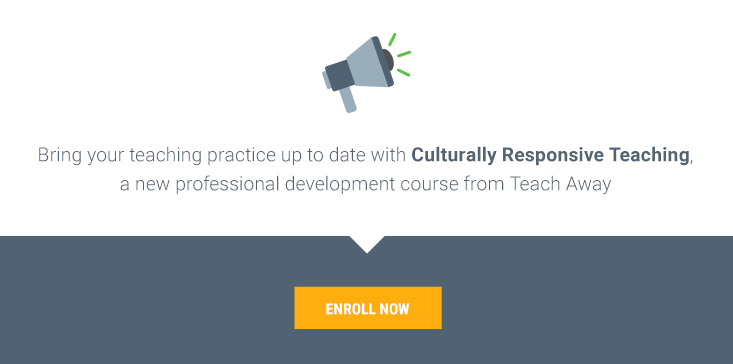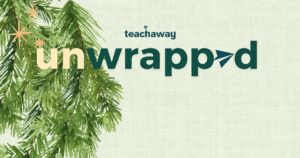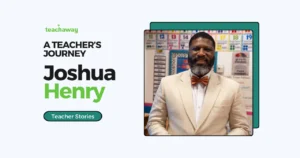Teachers today hear a lot of talk about overcoming gaps in education – especially the cultural gap between students and teachers.
As the students we teach grow more and more diverse, we know how critical it is to engage all of our students in ways that are culturally appropriate. While my teaching preparation program had dipped into some of the theories around culturally responsive teaching, it was pretty light on the practical side.
Fresh out of teachers college, I was looking for a flexible professional development offering that would give me the opportunity to uncover best practices, learn new strategies and become better equipped to work with diverse students and parents. Despite the current emphasis placed on the importance of culturally responsive teaching, there was surprisingly very little in the way of professional learning opportunities out there on this very topic.
Happily, an online search led me to discover Teach Away Professional Development and their new online course offering, Culturally Responsive Teaching: Connecting with students and parents of different cultures, centered on establishing cultural inclusivity in the classroom and school community.
Culturally Responsive Teaching course overview
- Course name: Culturally responsive teaching: Connecting with students and parents of different cultures
- Time: 1.5 hours
- Course fee: $99
- Delivery format: 100% online
- Assessment: Multiple choice exam and written assignment
- My verdict: Yes, this course is worth your time!
Read on to learn more about my experience taking the course.
What I learned from the Culturally Responsive Teaching course
Professional development courses, in my opinion, need to offer concrete takeaways that teachers can implement in their classrooms right away.
This online course offered me all this in the form of lesson plan structures, downloadable activities to help me reflect on my own practice, as well as simple tasks to help me build inclusivity through co-teaching and pedagogical documentation exercises.
The course also taught me about the unseen aspects of culture which may play a role in establishing an inclusive classroom. These unseen aspects of culture, like variations in language patterns, tone of voice, facial and hand gestures, and beliefs about gender and sexual orientation impact the dynamics of the classroom.
Culturally Responsive Teaching taught me how to carefully address these cultural differences with students and parents, instead of assuming that ignoring the differences makes the classroom a culturally neutral space. It also helped me to understand how to bring students’ families into the school community. In spaces where learners are not all included, we cannot say there is equal access to knowledge and education.
Culturally responsive teaching: Bridging theory and practice
This course is based upon ample research completed by renowned educational theorists. Notable theories and content highlighted came from Geneva Gay and Fred Korthagen, as well as other prominent researchers in the field of culturally responsive teaching.
The best part about Culturally Responsive Teaching, though? It actually moved beyond theory and offered practical strategies for the classroom.
For example, two popular concepts in education are pedagogical documentation and establishing critical thinking skills in students through inquiry-based activities. This course offered me easy takeaways to actually tackle these complex activities in the classroom, which hasn’t often been the case in other professional development courses for teachers I’ve taken before.
The final assignment gives an outline to create a resource portfolio that would welcome parents and students to your classroom by focusing on cultural inclusion. Instructions are given to develop a lesson plan, resource list, framework and rationale for an area of focus.
A comment I hear time and again from other teachers is that the last thing they need is another task piled on them at work.
I get it, time is precious! Through this course, I learned that being a culturally inclusive educator does not mean you’re adding another task on top of what you already need to do. One thing to remember is to take the process of becoming culturally competent one step at a time.
On the road to becoming a culturally competent teacher
Culturally Responsive Teaching helped me realize my own biases and personal assumptions and where I had opportunities to grow professionally in terms of cultural inclusivity. Learning how to include all cultures and understanding differences even in our own countries means identifying what you know and do not know, and this course helps you to do this in a non-judgemental way.
Geneva Gay, whose work is often cited throughout Culturally Responsive Teaching, states that schools’ values and actions are not culturally neutral, as one may believe. Everything from classroom discipline, to teaching, to the levels of student and teacher responsibilities reflect the dominant cultural ideology and can cause a disconnect between students’ school and personal lives.
The course taught me that culture will be shaped around us and the interactions we have every day with students and their parents or guardians. Just as we teach numeracy and literacy, we must also teach students how to develop ethnic and cultural literacy. By providing information about history and contributions of ethnic groups in class, students will be included and committed to learning and participating in globalized settings.
Overall, I would recommend Culturally Responsive Teaching to any teacher, regardless of the subject or grade you teach. It was reasonably priced, useful, easy to follow and – most importantly – relevant to my teaching practice.




